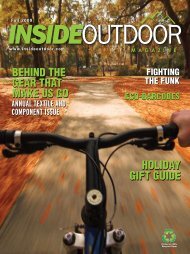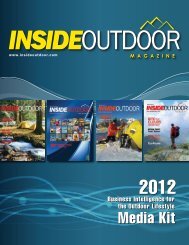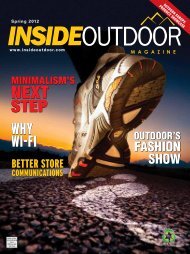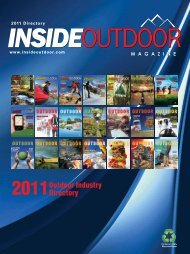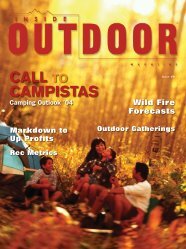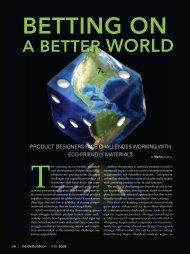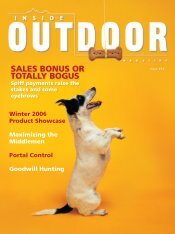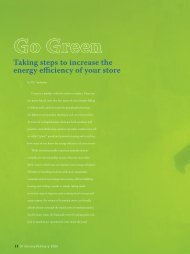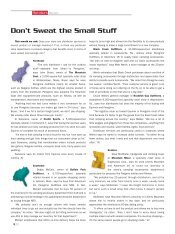Waterproof/Breathable Exposure
Waterproof/Breathable Exposure
Waterproof/Breathable Exposure
You also want an ePaper? Increase the reach of your titles
YUMPU automatically turns print PDFs into web optimized ePapers that Google loves.
in his opinion, the breathability of the product on his store’s sales floor.<br />
By using a tea kettle to measure how quickly steam moves through<br />
fabric and shower tests to measure waterproofness, Johnson compiles his<br />
own data then organizes the information forming fabric comparison sheets<br />
Breathability Comparison of Commercial Outerwear Pieces<br />
for his employees. (Please see sidebar below.) Johnson also encourages<br />
his employees to field test product themselves and submit their own<br />
evaluation of its effectiveness.<br />
Bob Sass, retail manager at Midwest Mountaineering, finds Johnson’s<br />
fabric rankings “amazingly effective” when giving recommendations<br />
to customers. “The list is compiled based on our experience with the<br />
product, which is how most stores form opinions,” says Sass. “But we<br />
also are able to describe how fabrics fare in relatively controlled testing<br />
environments – like the steam tests. It reinforces to customers<br />
that our opinions are pretty objective.”<br />
Johnson’s methods are by no means “pure” in a scientific<br />
sense, but they do provide his sales staff with another arrow<br />
in their quiver with which to better inform customers and fill<br />
individual needs. Another tool, one utilized by the United<br />
States military, is data compiled by the U.S. Army Soldier<br />
Systems Center lab, in Natick, Mass. The Natick lab is a<br />
large testing facility that evaluates clothing, food, parachutes<br />
and physiological reactions of soldiers in order to make gear<br />
recommendations to the military.<br />
Dr. Phil Gibson, a materials science engineer for the Natick<br />
lab, has tested apparel from the outdoor industry for more<br />
than 10 years. In that time he has conducted thousands of<br />
tests measuring waterproofing and breathability. One test that<br />
Gibson considers particularly effective – and objective – is the<br />
“Water Vapor Diffusion Test.”<br />
As can be seen in the table above, the vertical axis measures<br />
water vapor flux, which is the actual quantity of water vapor that<br />
evaporates through the material. It measures how many grams<br />
went through one square meter of fabric in one day. The higher<br />
number is equivalent to more water vapor escaping, which<br />
translates into a material being more breathable.<br />
The horizontal axis is the mean relative humidity, which represents<br />
the amount of water vapor available to be dispersed, which in a real-<br />
Rod’s Results<br />
As president and owner of Midwest Mountaineering in<br />
Minneapolis, Rod Johnson has seen nearly every fabric imaginable<br />
come in and out of his shop. Like other retailers, Johnson for years<br />
found himself at the mercy of manufacturers’ marketing materials<br />
when it came to figuring out which fabrics worked best.<br />
Then in 1996, during a kayak trip through the Grand Canyon,<br />
Johnson was wearing underwear from a leading manufacturer<br />
underneath a Gore-Tex drysuit. “It would get wet and take forever<br />
to dry,” says Johnson. “I thought there must be something better,<br />
and I decided to start conducting my own tests.”<br />
Base Layer Brand/Material<br />
100-percent cotton<br />
SmartWool underwear<br />
Micro fleece<br />
The North Face polyester base layer<br />
Marmot polyester base layer<br />
Drying Times<br />
110 minutes<br />
91 minutes<br />
85 minutes<br />
67 minutes<br />
67 minutes<br />
To test the mid-weight base layers, Johnson would wet each<br />
garment (by holding it under a faucet), run it through the spin<br />
cycle of his store’s washing machine, and then wear it with a shirt<br />
over top while walking around his office and record the drying<br />
times. He then passed out a list of the results for the employees<br />
to consider when making recommendations to customers. At<br />
bottom left is a list of his results.<br />
Johnson’s W/B Results<br />
1. eVENT ( “I have found that it breathes so well, armpit zippers are<br />
not necessary,” says Johnson.)<br />
2. The North Face Atmosphere (Hydro Gore-Tex)<br />
3. Marmot Oracle; Gore-Tex XCR; Marmot Precip<br />
4. Gore-Tex PacLite<br />
5. MontBell Versalite<br />
6. The North Face HyVent<br />
7. Marmot Chinook (Seams not sealed, water repellant/breathable)<br />
8. Patagonia Velocity (Seams not sealed, water repellant)<br />
Terramar polyester base layer<br />
Patagonia polyester base layer<br />
Lifa polypropylene base layer<br />
Brynje polypro fishnet base layer<br />
67 minutes<br />
55 minutes<br />
48 minutes<br />
24 minutes<br />
In order to determine approximate breathability of a waterproofbreathable<br />
jacket, Johnson held various jackets and materials<br />
over a steamer. The amount of steam observed passing through<br />
created the above results, with rankings from best to worst.



